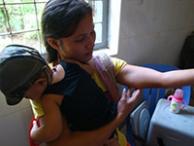Underutilized Commodities for Health
 When the inaugural issue of the Global Health: Science and Practice (GHSP) Journal was launched this week I was delighted to see articles on the use of chlorhexidine for umbilical cord care to improve newborn survival and the promise of contraceptive implants to meet growing family planning demand. What do these two articles have in common? They both discuss one of the 13 underutilized commodities for health identified by the UN Commission on Life-Saving Commodities for Women and Children, which is a part of the Every Woman, Every Child movement.
When the inaugural issue of the Global Health: Science and Practice (GHSP) Journal was launched this week I was delighted to see articles on the use of chlorhexidine for umbilical cord care to improve newborn survival and the promise of contraceptive implants to meet growing family planning demand. What do these two articles have in common? They both discuss one of the 13 underutilized commodities for health identified by the UN Commission on Life-Saving Commodities for Women and Children, which is a part of the Every Woman, Every Child movement.
The Commission selected commodities according to the global burden of disease and the evidence of their efficacy and safety for addressing the reproductive, maternal, newborn and child health ‘Continuum of Care’ that were receiving limited funding and showed untapped potential:
Maternal health
- Oxytocin (for post-partum hemorrhage)
- Misoprostol (for post-partum hemorrhage)
- Magnesium Sulfate (for eclampsia and severe pre-eclampsia)
Newborn health
- Injectable antibiotics (for newborn sepsis)
- Antenatal corticosteroids (for preterm respiratory distress syndrome)
- Chlorhexidine (for newborn cord care)
- Resusciation devices (for newborn asphyxia)
Child health
- Amoxicillin (for pneumonia)
- Oral rehydration salts (for diarrhea)
- Zinc (for diarrhea)
Reproductive health
- Female condoms (for family planning/HIV prevention)
- Contraceptive implants (for family planning)
- Emergency contraception (for family planning)
The scale up of these 13 commodities would also make a major contribution to achieving the goals set out in the Child Survival Call to Action, which challenged the world to reduce child mortality to 20 or fewer child deaths per 1,000 live births in every country by 2035.
The UN Commission recognized that major barriers that prevent the utilization of these commodities include lack of awareness of how, why and when to use them, financial constraints and socio-cultural issues. A Technical Reference Team (TRT) on Demand and Utilization was established, convened by USAID, to spearhead global action that would support country-level interventions to increase demand for and utilization of health services and products, through strategic behavior change communication, social marketing and other demand generation strategies.
HC3 is leading implementation of the TRT’s global initiatives, synthesizing current evidence related to demand creation across the commodities, identifying recommendations for the application of information and communication technologies (ICT) and new media, and developing resources and tools that can help kick-start the process for demand creation in countries. The TRT is also developing strategic communication tools on engaging with private sector organizations and forging innovative partnerships. Such partnerships may take a number of different forms, including collaboration with the media and entertainment industries to support inclusion of health messaging in commercial productions, or partnerships with businesses to provide demand creation activities as part of workplace-based healthcare.
Hopefully in the future, we will see more evidence on these 13 underutilized commodities emerging in GHSP and other journals and forums. There is a need to improve our understanding of the social and behavioral barriers and facilitators to their uptake among a range of audiences – caregivers, service providers, religious leaders and policymakers – and share lessons learned on the implementation of strategic interventions to increase demand for these 13 commodities. If that is done well and then coupled with improved supply and effective regulation, we could save the lives of more than 6 million women and children.






Leave a Reply
Want to join the discussion?Feel free to contribute!